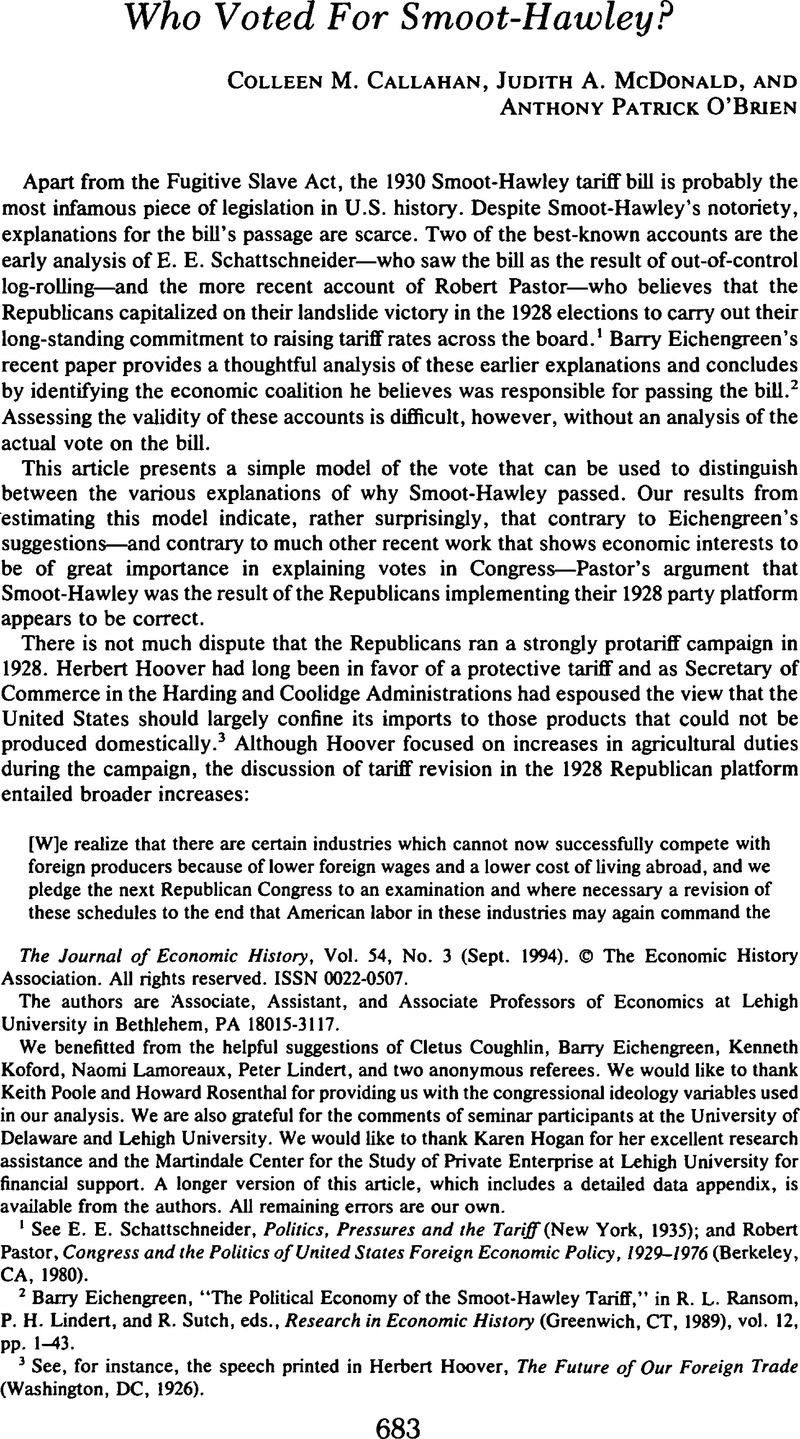Published online by Cambridge University Press: 03 March 2009

1 See Schattschneider, E. E., Politics, Pressures and the Tariff (New York, 1935)Google Scholar; and Pastor, Robert, Congress and the Politics of United States Foreign Economic Policy, 1929–1976 (Berkeley, CA, 1980).Google Scholar
2 Eichengreen, Barry, “The Political Economy of the Smoot-Hawley Tariff,” in Ransom, R. L., Lindert, P. H., and Sutch, R., eds., Research in Economic History (Greenwich, CT, 1989), vol. 12, pp. 1–43.Google Scholar
3 See, for instance, the speech printed in Hoover, Herbert, The Future of Our Foreign Trade (Washington, DC, 1926).Google Scholar
4 “Republican Platform [of 1928]” as reprinted in Schlesinger, Arthur M. Jr., Israel, Fred L., and Hansen, William P., eds., History of American Presidential Elections, 1789–1968 (New York, 1971), vol. 3, p. 2627.Google Scholar For Hoover's views on the tariff, see Hoover, Herbert, The Memoirs of Herbert Hoover: The Cabinet and the Presidency, 1920–1933 (New York, 1952), Chap. 41.Google Scholar
5 Eichengreen, , “Political Economy,” p. 10.Google Scholar
6 Ibid., p. 12.Google Scholar
7 Although Eichengreen does not specifically mention divisions between urban and rural interests, one might expect that urban interests would be protariff, whereas rural interests would be antitariff. However, party affiliation appears to have dominated all urban-rural interests. For example, only two Republicans representing urban districts voted against final passage, whereas only two Democrats representing urban districts voted in favor of final passage of the bill.
8 Only 25 Republicans are listed in Table 1. This is because we did not include William H. Sproul (from Kansas) who voted present on initial and no on final passage and Hubert H. Peavey (from Wisconsin) whose final vote was no, but whose initial vote we were unable to determine.
9 Eichengreen, , “Political Economy,” p. 12.Google Scholar
10 We included members who were listed in the Congressional Record (06 14, 1930, pp. 10789–90)Google Scholar as not voting, but paired. We counted as a Democrat the one Farmer-Labor representative.
11 Once again, we included members who were listed in the Congressional Record (05 28, 1929, p. 2106)Google Scholar as not voting, but paired. Sometimes a member was replaced between the initial and final votes. If the replacement was from the same party, then we proceeded as if the votes were cast by the initial member. Only James M. Beck, a Republican representing the 1st District in Pennsylvania, voted no on the first vote and yes on the second vote. He was excluded from the analysis.
12 U.S. Department of Commerce, Bureau of the Census, Fifteenth Census of the United States, Biennial Census of Manufactures: 1929, Vol. 3: Reports by States (Washington, DC, 1932).Google Scholar
13 We used the definitions of Congressional districts given in Martis, Kenneth, The Historical Atlas of United States Congressional Districts: 1789–1983 (New York, 1982)Google Scholar and assigned industries to SIC categories using the classifications in Niemi, Albert Jr., State and Regional Patterns in American Manufacturing: 1860–1900 (Westport, CT, 1974).Google Scholar
14 The thrust of Eichengreen's argument is best represented by the classification of two-digit SIC industries into heavy and light manufacturing used in the analysis presented in Tables 2 and 3. If Eichengreen's coalition analysis is to be meaningfully distinguished from that of Schattschneider's log-rolling analysis, then Eichengreen's coalitions must be made up of fairly broad industry groups. However, we also performed probit and ordered probit estimations in which the SIC variables were disaggregated by industry. Including disaggregated industry variables at the two-digit SIC level did not add significantly to the percentage of the vote correctly predicted. These results are available from the authors.
15 We also tried an alternative definition of light industry: the sum of the values for SICs 22, 23, and 31. This alternative was consistently insignificant and is excluded from our results.
16 We considered the following districts to be northern-border agriculture: all districts in the states of Idaho, Montana, North Dakota, New Hampshire, Vermont, and Maine; in Washington: 4th and 5th; in Minnesota: 1st, 2nd, 6th, 8th, and 9th; in Wisconsin: 3rd, 7th, 8th, 9th, 10th, and 11th; in Michigan: 4th, 7th, 10th, 11th, and 12th; in Ohio: 4th, 5th, 8th, 13th, and 17th; in Pennsylvania: 27th and 28th; and in New York: 31st, 32nd, 36th, and 37th. We also tried an alternative definition of this variable, which, in addition to the districts included in BORDER AGRICULTURE, added all of the districts in South Dakota, Colorado, and Arizona in order to include all of the districts in the states in which, according to Eichengreen, (“Political Economy,” p. 8)Google Scholar: “the foreclosures of the second half of the 1920s were most heavily concentrated…[and which were] the sources of strongest pressure for agrarian relief.” Because this alternative variable was consistently insignificant, it is not included in our results.
17 Eichengreen, , “Political Economy,” p. 12.Google Scholar
18 The unemployment data are from the U.S. Department of Commerce, Bureau of the Census, Fifteenth Census of the United States, Unemployment, Volume 1 (Washington, DC, 1931).Google Scholar
19 For a thorough description of how these series were generated, see Poole, Keith T. and Rosenthal, Howard, “Patterns of Congressional Voting,” American Journal of Political Science, 35 (02 1991), pp. 228–78.CrossRefGoogle Scholar
20 For a discussion of the condition index, see Belsley, David A., Kuh, Edwin, and Welsch, Roy E., Regression Diagnostics: Identifying Influential Data and Sources of Collinearity (New York, 1980), pp. 105 and 153CrossRefGoogle Scholar; and Judge, George G. et al. , Introduction to the Theory and Practice of Econometrics (New York, 1988), p. 872.Google Scholar
21 For instance, despite the presence of the automobile industry, with the exception of one absent member, all of Michigan's representatives voted in favor of final passage.
22 The test statistic used is two times the difference between the likelihood functions, as discussed in Amemiya, Takeshi, “Qualitative Response Models: A Survey,” Journal of Economic Literature, 19 (12 1981), pp. 1483–1536.Google Scholar

The critical chi-square at the 001 level with one degree of freedom is 10.08. We conclude that column 3 is the preferred specification.